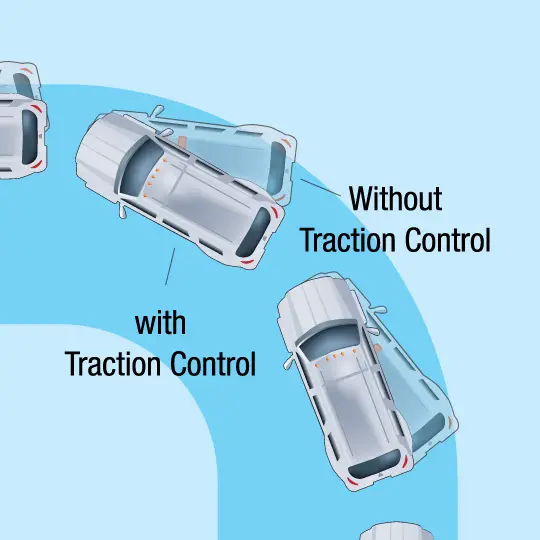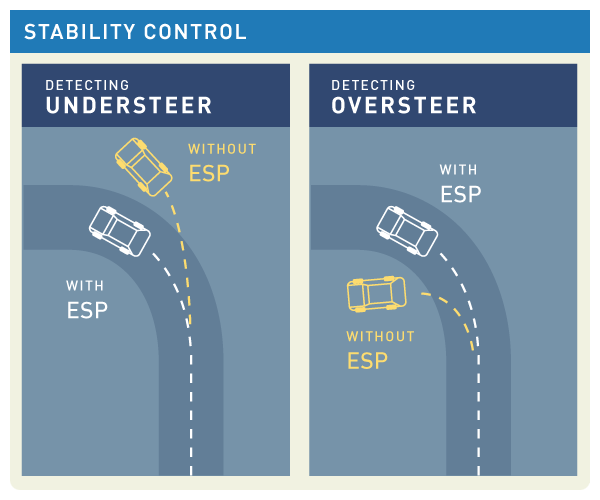Traction Control vs. Stability Control: What’s the Difference?
You’re driving along and all of a sudden, your car starts to slide. Your heart races as you try to regain control, but no matter what you do, you can’t seem to stop the skid. In situations like this, you’re glad your car is equipped with traction control. But what exactly is traction control? And how does it differ from stability control? Read on to find out.
What is Traction Control and What Does It Do?
Most drivers have heard of traction control, but don’t really know what it does. Traction control is a system that helps keep the car from skidding or slipping on slick surfaces.
When the system detects that the tires are losing traction, it intervenes and applies the brakes to individual wheels to get them back under control.
This is a very important system for safety, especially when driving in bad weather. It can help you avoid skids and keep your car under control. Traction control can also help you save on gas, since it reduces the amount of wear and tear on your tires.
If you’re not sure whether your car has traction control, check your owner’s manual. If you don’t have one, most cars made in the last few years will have this system. It’s a great feature to have, so be sure to take advantage of it when conditions are tricky!

Traction Control Systems
Traction control is a system that helps drivers maintain traction while accelerating. It does this by sensing when one or more wheels are beginning to spin and then reduces engine power or applies the brakes to that wheel or wheels until traction is regained.
In short, traction control keeps your car from slipping and sliding on slippery surfaces.
Most newer cars come equipped with traction control systems, but they’re not foolproof. For example, if you’re trying to accelerate up a steep, icy hill, there’s a good chance your tires will spin even with traction control engaged.
In situations like this, it’s best to take it slow and use a lower gear than usual to help keep your tires from slipping.
What is Stability Control and What Does it Do?
Stability control is a system that helps drivers maintain control of their vehicles during difficult driving conditions. It does this by using sensors to track the position of the car and then braking individual wheels to keep the car stable. Stability control is a very important safety feature and it can help drivers avoid accidents in slippery conditions or when they lose control of their car.

Stability Control Systems
Stability control is similar to traction control in that it helps drivers maintain control of their vehicles. However, stability control goes a step further by also helping drivers maintain control during emergency maneuvers.
For example, if you have to swerve suddenly to avoid an animal in the road, stability control will help you keep your car from fishtailing or tipping over.
All vehicles manufactured after September 1, 2011 must be equipped with stability control systems. If your car was manufactured before this date and doesn’t have a stability control system, consider having one installed—it could save your life.
How Do Traction Control and Stability Control Work Together to Keep Your Car Safe on the Road?
When you’re driving, you rely on your car’s stability and traction control systems to keep you safe. These systems work together to ensure that your car stays in control, even when the road conditions are less than ideal.
Traction control helps you to stay in control of your car by preventing it from slipping and sliding. It does this by monitoring the speed of each individual wheel and applying the brakes to the wheels that are spinning too fast. This system is important when you’re driving on slippery surfaces, such as ice or snow.
Stability control helps to keep your car stable when it’s turning or going around corners. It does this by detecting when your car is starting to lose control and then applying the brakes or adjusting the engine power to help keep it on track. This system is important when you’re driving on curved roads or in bad weather conditions.
Together, these two systems work to keep your car safe on the road. They help you to maintain traction and stability no matter what the conditions are like outside. So next time you hit the road, don’t forget to rely on your car’s stability and traction control systems!
When Should You Use Traction Control – and Why?
When it comes to driving, you want to be in control. You need to be able to rely on your car to do what you tell it to – when you tell it to. With traction control and stability control, you can feel confident that your car is doing what you expect it to. But when should you use which system?
Traction control is perfect for slippery surfaces. If you’re driving on a wet road, or if there’s ice on the ground, traction control will help keep your car under control.
It does this by monitoring the wheels and ensuring that each one is getting the right amount of power. If one wheel starts to spin, the traction control system will cut power to that wheel until it’s back under control.
Stability control is perfect for uneven surfaces. If you’re driving on a road with bumps and potholes, stability control will help keep your car stable.
It does this by monitoring the position of the car and ensuring that it stays level. If the car starts to drift sideways, the stability control system will apply power or brakes to correct it.
How Can You Tell Which System is Currently Active in Your Car?
There can be more than one car system active in your car at the same time. However, only one of these systems is currently active. The active system is the one that is controlling the car’s functions. You can tell which system is currently active by looking at the car’s dashboard.
The car’s dashboard will have a display that shows which system is currently active. If you are driving a car with a traditional key ignition, then the key will also have a symbol that indicates which system is currently active. The key symbol will be different for each system.
If you are driving a car with a keyless ignition, then the keyless ignition button will have a symbol that indicates which system is currently active. The keyless ignition button symbol will be different for each system.
Which System is Better – Traction Control or Stability Control – and Why?
There is no definitive answer as to which system is better – traction control or stability control. Both systems have their pros and cons, and it ultimately comes down to what the driver prefers and what type of driving they will be doing.
Traction control is great for drivers who want more power and handling out of their car. It helps to keep the car stable when accelerating, and prevents it from spinning out when taking corners at high speeds. However, traction control can also be a bit intrusive – it can sometimes make the car feel sluggish or unresponsive.
Stability control, on the other hand, is perfect for those who want a more relaxed driving experience. It helps to keep the car stable during turns and braking, which makes it easier to drive on slippery surfaces or in bad weather conditions. However, stability control can also be a bit too cautious at times, which can lead to slower acceleration and cornering.
Frequently Asked Questions (FAQs)
Q1: What is the primary purpose of Traction Control?
A1: Traction Control is designed to prevent wheel spin during acceleration by reducing engine power or applying individual brake forces to specific wheels, ensuring optimal grip on slippery surfaces.
Q2: How does Stability Control differ from Traction Control?
A2: Stability Control focuses on maintaining the vehicle’s intended path during cornering by selectively applying brakes to individual wheels, helping to prevent skidding or loss of control.
Q3: Are Traction Control and Stability Control the same thing?
A3: No, they are distinct systems. Traction Control addresses wheel spin during acceleration, while Stability Control intervenes during cornering to prevent skidding and maintain control.
Q4: Are these systems only useful in adverse weather conditions?
A4: While Traction Control and Stability Control are particularly beneficial in slippery conditions, they also enhance overall vehicle safety and stability in various driving situations, including emergency maneuvers.
Q5: Can these systems be turned off?
A5: Most modern vehicles allow drivers to disable Traction Control and Stability Control temporarily. However, it’s important to note that turning off these systems may reduce the vehicle’s stability and traction, particularly in challenging driving conditions.
Wrap Up!
No matter what type of vehicle you drive—a sedan, SUV, truck, or van—it’s important that it has some form of traction and stability control system installed. These systems are designed to help drivers maintain control of their vehicles under adverse conditions and can be the difference between remaining safe on the road and being involved in a serious accident.
If you’re not sure if your car has these systems installed, check your owner’s manual or ask your mechanic during your next visit. And if you’re in the market for a new car, be sure to choose one that comes equipped with both traction and stability control—your safety may depend on it.
